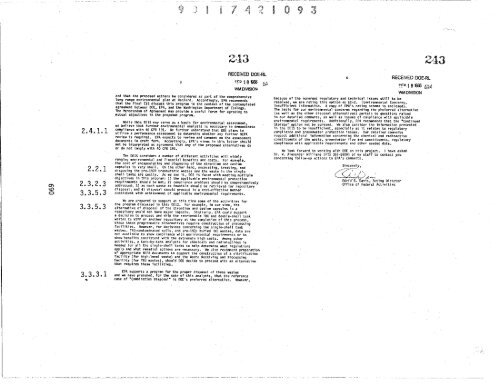EIS-0113_Section_11 - Hanford Site
EIS-0113_Section_11 - Hanford Site
EIS-0113_Section_11 - Hanford Site
Create successful ePaper yourself
Turn your PDF publications into a flip-book with our unique Google optimized e-Paper software.
N'$ J 2413<br />
2.4.1.1<br />
2.2.1<br />
2.3.2.3<br />
M Lo<br />
0 3.3.5.3<br />
3.3.5.3<br />
3.3.3.1<br />
RECEIVED DOE-RL<br />
crp<br />
18 M w^,<br />
wM DIVISION<br />
and that the proposed actions be considered as part of the comprehensive<br />
long range environmental plan at <strong>Hanford</strong>. Accordingly, EPA reco mm ends<br />
that the Final <strong>EIS</strong> discuss this program in the context of the contemplated<br />
agreement between DOE, EPA, and the Washington Department of Ecology.<br />
The Memorandum of Agreement may provide a useful forma for agreeing to<br />
mutual objectives in the Proposal program.<br />
While this D<strong>EIS</strong> may serve as a basis for environmental assessment,<br />
we believe that further environmental analysis is necessary to demonstrate<br />
caaPliance with 40 CFR 191. We further understand that DOE plans to<br />
utilize a performance assessment to determine. whether any further NEPA<br />
review is required. EPA expects to review and comment on the assessment<br />
documents in draft form. Accordingly, EPA's views in this letter should<br />
not be interpreted as agreement that any of the proposed alternatives do<br />
or do not comply with 40 CFR 191.<br />
Th e D<strong>EIS</strong> considers anumber of different activities with widely<br />
ranging environmental and financial benefits and costs. For example,<br />
the cost of encapsulating and disposing of the st ro ntium and cesl um<br />
capsules is very small. on the other hand, excavating, treating, and<br />
disposing the pre-19 7 0 transuranic wastes and the waste in the single<br />
shell tanks are costly. As we see it, DOE is faced with meeting multiple<br />
objectives in this program! 1) the applicable environmental protection<br />
requirements should be met; 2) compliance problems should be comprehensively<br />
addressed; 3) as much waste. as feasible should be retrieved for repository<br />
disposal; and 4) disposal should proceed in a cost-effective manner<br />
consistent with achievement of applicable environmental requirements.<br />
We are prepared to support At this time some of the activities for<br />
the program discussed in this D<strong>EIS</strong>. Fore ample, in our view, the<br />
alternative of disposal of the strontium and cesium capsules in a<br />
repository would not have major impacts. Similarly, EPA could Support<br />
a decision to process and ship the retrievable TRU and double-shell tank<br />
wastes to HIPP or another repository at the completion of this process,<br />
since these programmatic alternatives require construction of processing<br />
facilities. However, for decisions concerning the single-shell tank<br />
wastes, TRU-contaminated sails, and Pre C 19ZO buried TIE D wastes, data are<br />
not available to show compliance with environmental requirements or to<br />
Show benefits consistent with the extremely high costs. Among other<br />
activities, a tank-by-tank analysis for chemicals and radionuclides is<br />
needed for all the single-shell tanks to help determine what regulations<br />
apply and what remedial actions are necessary. We also recommend preparation<br />
of appropriate NEPA documents to support the construction of a vitrification<br />
facility (for high-level waste) and the Waste Receiving and Processing<br />
Facility (for TIN wastes), should WE decide to proceed with an alternative<br />
that requires these facilities.<br />
EPA supports a program for the proper disposal of these wastes<br />
and we have presumM, for the sake of t hi s analysis, that the reference<br />
case of 'Combination Disposal' is DOE's Preferred alternative. However,<br />
4 RECEIVED DOE-RL<br />
or" : 18" Gill<br />
WM DIVISION<br />
because of the numerous regulatory and technical issues still to be<br />
resolved, we are rating this option as EC-2 (Environmental Concerns,<br />
Insufficient Information. A copy of EPA's ra ti ng scheme is enclosed).<br />
The basisfor our environmental concerns regarding the (deferred alternative<br />
(as well as theother disposal alternatives) pertain to questions raised<br />
in our detailed comments, as well as issues of compliance with applicable<br />
environmental requirements. Additionally, EPA recommends that the 'Continued<br />
Storage- option not be pursued. We also consider information presented<br />
In the D<strong>EIS</strong> to be insufficient, especially as it relates to regulatory<br />
compliance and groundwater protection issues, our detailed co mm ents<br />
request additional inf ormation concerning the chemical and radioactive<br />
constituents of the waste, groundwater flow and constituents, regulatory<br />
compliance with applicable requirements and other needed data.<br />
He look forward to working with DOE on this project. 1 have asked<br />
Dr. W. Alexander Wi l li ams (FTS 382-5909) of my Staff to contact you<br />
conce rning follow-up actions to EPA's co mm ents.<br />
Sincerely,<br />
—<br />
Ddvtd' '. ^avis,Acting Director<br />
Office of Federal Activities

















